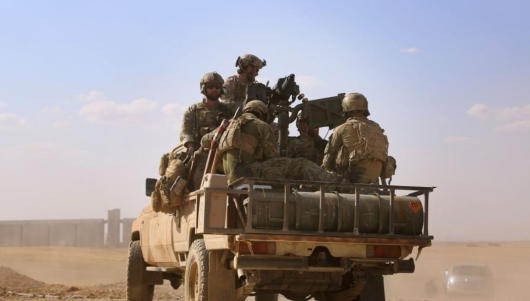Trump Launches 8-Nation Operation to Block Iran’s Takeover of Syrian-Iraqi Border. ISIS Left for Later
The US is preparing to embark on its biggest military venture in the Middle East since Gen. David Petraeus’ 2006 troop surge in Iraq: It is the battle for the 600km-long Syrian-Iraqi border.
President Donald Trump will present his first military venture against Iran to Saudi King Salman and the bevy of Arab leaders coming to meet him when he lands in Riyadh on May 22. After that, he will brief Prime Minister Binyamin Netanyahu when they get together the next day in Jerusalem.
Word of this campaign has scarcely broken through to the public notice through the flames and smoke of the firestorms besetting the Trump administration in Washington, culminating Wednesday in the appointment of a former FBI chief to probe the accusations the media have leveled against him.
DEBKA Weekly’s military and intelligence sources can reveal here, however, that Lt. Gen. Stephen J. Townsend, commander of the Combined Joint Task Force – Operation, has put together a formidable army of some 3,000 elite troops from eight countries: the US, Britain, Jordan, Germany, Netherlands, Denmark, Croatia and the Czech Republic.
The US Air Force will provide air support from the Ayn al-Asad airbase in Iraq.
This was the operation President Trump was referring to, when he commented mysteriously: “Our generals are doing big things that we will hear about, maybe even next week.”
It has three objectives:
1. To disconnect the overland routes from Iran to Syria and the Mediterranean via Iraq, thereby snatching from Tehran its hoped-for prize from supporting Bashar Assad.
As soon as the Iranians got wind of the coming offensive, they determined to wrench the war wheel round by calling up all their Shiite militia assets in southern Iraq and transferring them at top speed to the Syrian border, with orders to seize segments not yet controlled by the US-led force.
By now, 25,000-30,000 troops have gathered under the Iranian flag at a strategic location outside Ar-Rutbah on the Baghdad-Amman highway in Iraq’s western Al Anbar province. Thursday, May 18, the army was still about 100km east of the Syrian border.
2. To cut off supplies from Tehran via Iraq to pro-Iranian forces, including Hizballah, which are fighting in Syria, and to also to sever the cross-border supply routes linking Islamic State forces based in Syria and Iraq.
3. To revise the order of priorities for the war on ISIS. If Trump’s campaign for control of the 600km-long border is successful, the US coalition will postpone the offensive for taking the ISIS Syrian stronghold of Raqqa and go first for the jihadist group’s concentrations further east at Deir ez-Zour.
DEBKA Weekly’s military sources report that the US-led coalition army has split up between two sectors:
The northern sector, which also covers the Kurdish cantons of Hasakeh and Qamishli, is manned by 1,000 US troops who, by Thursday night, May 25, had been distributed among ten locations.
In this sector, the American generals are driving for full control of two border crossings – Rabia, on the road to the embattled Iraqi town of Mosul; and Semalka on a pontoon bridge thrown across the Tigris by the Kurdistan Regional Government about a kilometer downstream from the Iraqi-Syrian-Turkish border intersection.
The possible co-option of Turkish command forces to the American units in this sector was discussed on May 16 during Trump’s conversation with visiting Turkish President Tayyip Erdogan at the White House.
Our intelligence sources also reveal that Erdogan brought to Washington along with his delegation Masrour Barzani, intelligence chief of the semiautonomous KRG. The Turkish president assigned him the task of apprising President Trump of the dangers of giving the Syrian Kurdish YPG militia American heavy weapons, to which Erdogan is vehemently opposed. The Turkish leader left the White House emptyhanded.
In the southern sector, the coalition force, composed of fewer American and more coalition troops, aims for full control of two additional border crossings, Al-Tanf and Al-Qaim. The latter is situated midway between the Syrian border town of Abu Kamal and the Iraqi town of Al Qaim.
The impending battle for Al-Tanf is discussed in the next article.


